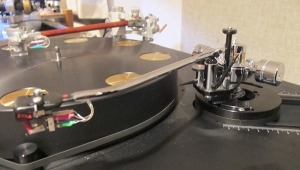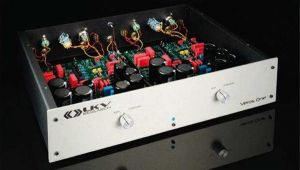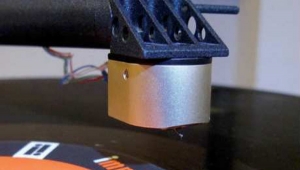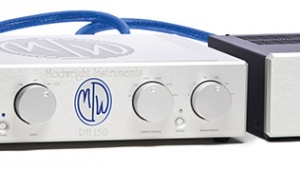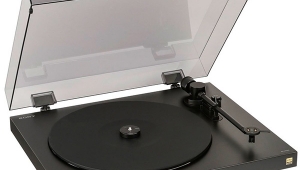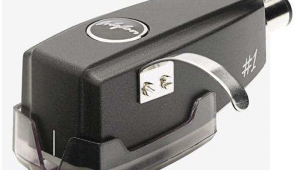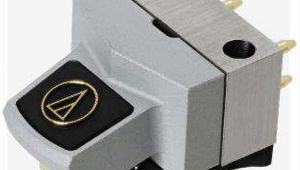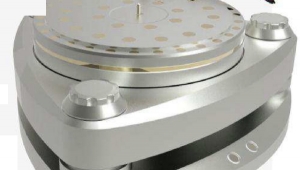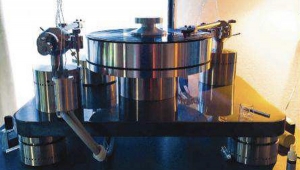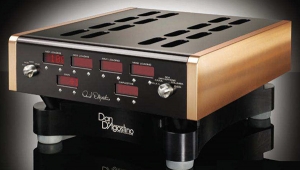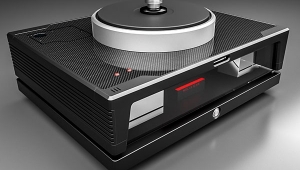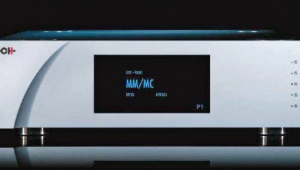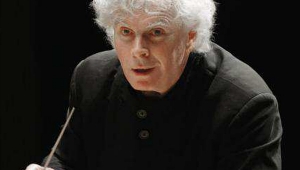| Columns Retired Columns & Blogs |
Analog Corner #250: Ikeda 9mono, van den Hul Crimson XGW cartridges, PBN GrooveMaster Vintage Direct turntable Page 2
Sound: Once set up and loaded at about 200 ohms using the Ypsilon MC-10L step-up transformer, with no resistors in the Ypsilon's loading jacks, the Crimson XGW produced sound unlike that of any other vdH cartridge I've reviewed. I'm preconditioned to the lightning-fast—some would say threadbare—excitement of vdH's tightly sprung Colibri and Grasshopper cartridges; the sound of the Crimson XGW was precisely the opposite: it was a warm, sweet, and well textured performance—and yet, arguably because of the stylus profile, it was well-detailed, as well.
Footnote 4: "Lullaby of Broadway" also appears on Bennett's At Carnegie Hall, recorded just two months earlier and reissued on vinyl (2 LPs, Columbia/Legacy/Analogue Productions APP 823), for the first time from the three-track master tape.

Rather than play familiar records, I began with unknowns, including Tony Bennett and Dave Brubeck's The White House Sessions, Live 1962 (2 LPs, Columbia/Legacy/Impex 602), recorded August 28, 1962, at the National Sylvan Theater, an outdoor amphitheater near the base of the Washington Monument. The tapes, long lost, were found in 2012, having been misfiled in Sony's archive of classical master tapes. The credits state that the tapes were mixed and mastered by Mark Wilder, at Battery Studios, and cut by Kevin Gray, at Cohearent Audio. The latter usually means from digital files, probably at 24-bit/96kHz, but in this case that's a guess—the closely miked sound decoded by the Crimson XGW was rich and full-bodied, yet three-dimensional and spookily transparent. I could feel and almost smell the humid, late-summer air. However, I felt that either the vdH was adding midband richness, or the humidity must have been 100%.
Joe Morello's well-textured kick drum had fully satisfying sock and dynamic thrust, while his various cymbals, though warmed by the outdoor setting, had pleasingly fast, precise attacks, as did his snare during a side-2 solo that produced surprising slam. Paul Desmond's alto sax, at center stage, was appropriately light and breathy—and the sound of Brubeck's piano, though slightly thickened, was equally convincing.
Side 3, on which Bennett is backed by the Ralph Sharon Trio, continued the impression that the Crimson XGW's sound tended toward the very rich but tonally well balanced, with a super-creamy, well-resolved midrange, and pleasingly fast but unhyped highs and transients. Bennett, center stage, sounded live-in-the-"room," cushioned by the night air. Bennett sings "I Left My Heart in San Francisco"—his hit single of the song had been released only the previous February—and if you set the level just right, you are there in a way that, in my opinion, no digital format can yet manage.
Side 4 is an impromptu Bennett/Brubeck collaboration that begins with "Lullaby of Broadway" (footnote 4). Although this set was a surprise for everyone, especially Columbia's engineers, the sound is superb. (It turns out that the late Frank Bruno, one of the location engineers, was the father of my wife's boss. I repeatedly tried to interview him, but he never wanted to talk.)
On the basis of The White House Sessions, Live 1962, I concluded that the Crimson XGW was a well-detailed yet rich-sounding cartridge with an essentially neutral tonal balance that nonetheless "pushed" a bit in the midband. I also concluded that it was a fine tracker that ignored minor LP blemishes, and produced impressively "black" backgrounds and wide, stable soundstages.

I then played many very familiar recordings (space does not permit a full accounting), including an original pressing, mastered by Artisan Sound Recorders, of the Grateful Dead's American Beauty (LP, Warner Bros. 1893). This confirmed the above observations, but also made clear that the XGW's emphasis was on instrumental textures, as well as on the riches of the upper bass and lower midband—and that its top end, while satisfying, produced less than the full measure of genuine air and sparkle. This may explain why van den Hul recommends such a wide range of loading options (25–200 ohms). In terms of rhythm'n'pace, the Crimson XGW tended toward the "slower, and let me linger over it" side of the speed divide.
There are faster, leaner, more detailed cartridges out there, including some at this price, but the Crimson XGW produced weight and structure that such models usually shortchange—and, of course, your tastes and associated equipment will strongly influence how this cartridge will sound to you in your system. For those who like full-bodied but not excessive meat-on-the-bone textures and full-figured harmonics, and who prize solid, three-dimensional imaging, the van den Hul Crimson XGW is well worth considering. I thoroughly enjoyed listening to it, particularly with vocal music and small-ensemble classical music, but less so on rock.

PBN Audio GrooveMaster Vintage Direct PBN-DP6 direct-drive turntable: $8500
The talented electronics designer Peter B. Noerbaek, who designs and manufactures electronics for PBN Audio (footnote 5) and Liberty Audio, also makes the handsome line of GrooveMaster Vintage Direct turntables, based on four classic Denon direct-drive models of the 1970s: the PBN-DP2, based on Denon's DP-2000 (1978); the PBN-DP3 (Denon DP-3000, 1973); the PBN-DP6 (Denon DP-6000, 1976); and the PBN-DP8 (Denon DP-80, 1980).
These designs differ slightly from one another, but each has a relatively lightweight platter of die-cast aluminum directly driven by an AC motor controlled by quartz-crystal oscillators and 4lb. A DC electrical brake system results in smooth operation and speed changes.
The prices, which include a Jelco tonearm, range from $5500 (PBN-DP3) to $9500 (PBN-DP8). Every original Denon 'table is completely disassembled and rebuilt. Noerbaek uses only the original's motor, platter, circuit board, and speed-sensing head. The boards are overhauled: the electrolytic caps and most of the transistors are replaced. Also new are the pushbuttons and potentiometers, the plate on which they're mounted, and the motor's massive aluminum mounting plate. "Good for another 40 years," says Noerbaek. Each GrooveMaster Vintage Direct goes into a gorgeous, curvaceous plinth available in a variety of hardwoods. The plinth is a laminate of three layers, each 1.625" thick, each layer's grain at an angle of 120° to the others. Before the stainless-steel caps and feet are added, each plinth weighs about 16 lbs.
The model supplied was the PBN-DP6, fitted with a Jelco SA-750EB—a 9.5" curved tonearm that retails separately for around $570. The cost of this combination is $8500. You can specify any tonearm you wish, but once it's installed, you can't later opt for a longer or shorter version. Almost all of the work is done in-house at PBN Audio, including the CNC woodworking and finishing. Noerbaek told me that the lead finisher at his factory works the day shift at PBN, and then an evening shift at Taylor Guitars, which is also based in El Cajon, California.
Noerbaek supplied a plug'n'play PBN-DP6 with a Lyra Etna cartridge already installed and aligned in the Jelco's headshell. All I had to do was set VTF, and plug in the straight DIN-to-RCA cable (supplied at extra cost) and the angled power cord.

Left: PBN-DP6, speed stability data. Right: PBN-DP6, speed stability (raw frequency yellow; low-pass filtered frequency green).
The PBN-DP6 was up and running within 10 minutes of being unpacked. Its built-in strobe confirmed that the platter was rotating at a precise 331/3 or 45rpm, with small deviations, as the excellent measurements shown in the graphs above demonstrate; the pitch is easily adjusted within ±6%.
Denon made and sold a lot of direct-drive turntables. Yes, you can go on eBay or elsewhere and find many for sale, with and without plinths, and in various conditions. So if you're into DIY, have fun! But for those who want a fully reconditioned Denon direct-drive in a drop-dead-gorgeous plinth, PBN has done all the work. The GrooveMaster Vintage Direct PBN-DP6 is a stunning-looking turntable you'll want to have on display.
Sound: The PBN-DP6's ribbed rubber record mat wouldn't be my first choice, but that's how I first listened to the turntable. I found that it was better to turn over the mat (ribs down), which creates a flat surface for the record to better couple to. (The raised center section of the PBN-DP6's platter will narrow your choice of alternate mats.)
I ended up using a Funk Firm Achromat on top of PBN's inverted mat, and raising the tonearm's pillar to maintain the proper vertical tracking angle (VTA) and SRA. I also used a Stillpoints Ultra LP Isolator atop the spindle, in place of the PBN's supplied record weight; the latter produced noticeably better bass, more solid images, and "blacker" backgrounds.
It was difficult to separate the PBN-DP6's sound quality from that of the inexpensive Jelco tonearm. All I can say is that that combination, with the Lyra Etna cartridge, produced the kind of smooth, open, well-articulated, effortless, stable reproduction of music that can easily convert almost anyone hooked on digital, and who is willing to do the minimal work required to spin records.

Recently, during a visit to High Fidelity, the Los Feliz, L.A., record store owned by Mike Hobson, cofounder of Classic Records, I found, for around $8, an original pressing of Charles Lloyd's Discovery (LP, Columbia CS 9067). I'd never had one and had always wanted it. At the time (1965), Lloyd was a member of the Cannonball Adderley Sextet, and this was his first recording session as leader, backed by Don Friedman on piano, with either Eddie Khan and Roy Haynes or Richard Davis and J.C. Moses on bass and drums, respectively. This wonderful recording, I thought, told me everything I needed to know about this turntable-tonearm combo—not that it was the only record I played! Backgrounds were quiet, images stable, and the bass was nimble and tight, if not as fully extended as what's on the record. The top end was wonderfully open and airy, with transients finely yet smoothly articulated, and a well-developed sense of studio space behind the players.
PBN's GrooveMaster Vintage Direct series isn't for the DIY crowd, and part of what you're paying for in the PBN-DP6 is its gorgeous looks—but for the guy or gal who wants a compact showpiece that will be trouble free, sound great, play at the correct speed, and likely remain dependable for years to come, one of these GrooveMasters would be a good choice.
Footnote 4: "Lullaby of Broadway" also appears on Bennett's At Carnegie Hall, recorded just two months earlier and reissued on vinyl (2 LPs, Columbia/Legacy/Analogue Productions APP 823), for the first time from the three-track master tape.
Footnote 5: PBN Audio, 380 Vernon Way, Suites I and J, El Cajon, CA 92020. Tel: (619) 440-8237. web: www.pbnaudio.com.
- Log in or register to post comments


